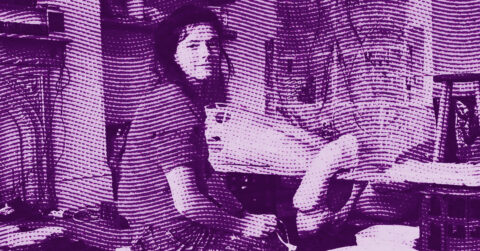Listen to me carefully, you bunch of snobs: Matthew Lutz-Kinoy is not an ordinary artist, and this becomes obvious from the first encounter with his polymorphic work. Born in 1984 in New York, based between Paris and Los Angeles, this one-man orchestra practices in a way that defies any lazy categorization attempt. His artistic production unfolds across a multiplicity of media, ceramics, large format painting, performance, dance and sculpture, as many territories he explores with insatiable curiosity and manifest erudition. But it would be a monumental mistake to see in this technical diversity a mere opportunism or amateur dispersion. On the contrary, each medium becomes for Lutz-Kinoy the vector of a thorough reflection on representation, identity, bodily pleasure, and narrative construction. His work is richly nourished by historical references, crossing without complex rococo, abstract expressionism, orientalism, and Brazilian and Japanese artisanal traditions, thereby weaving a complex web where past and present dialogue in a productive tension.
One of the keys to understanding Lutz-Kinoy’s work lies in his intimate relation with classical Japanese literature, more precisely with Murasaki Shikibu’s Genji Monogatari, considered one of the first novels in world literary history. Written in the early eleventh century, this monument of Japanese literature tells the love adventures and refined life of Prince Genji at the imperial court of Heian-kyo. This literary work is not for Lutz-Kinoy a simple source of superficial inspiration, but truly constitutes a narrative structure that he reinvests in his own artistic production. In 2015, during his exhibition in São Paulo titled Princess PomPom in the Villa of Falling Flowers, the artist explicitly used Murasaki’s tale as a conceptual foundation. In an interview with critic Tenzing Barshee, Lutz-Kinoy explains his approach: “It was interesting to use The Tale of Genji as a structure. Because it takes the form of a preexisting narrative for which you do not have to assume responsibility, it exists outside of you and your own meaning formation. So you can use it as a formal structure, which allows you to work more freely” [1]. This statement reveals an essential dimension of his artistic practice: the use of preexisting narratives as frameworks enabling increased creative freedom. The Genji Monogatari is therefore not just a decorative motif or an elegant cultural reference, but a structural device that allows Lutz-Kinoy to explore contemporary themes, notably gender issues, bodily transition, and pleasure, through the prism of a millennial narration. This strategy allows him to create a projection space where the corporeal and the narrative meet without one overshadowing the other.
Lutz-Kinoy’s interest in Japanese literature is not a matter of easy exoticism or unconscious cultural appropriation. The artist builds conceptual bridges between the cultural contexts he navigates. In Brazil, he observes the significant community of Japanese origin and feels a connection between his own status as a foreigner and this complex migratory history. But more fundamentally, he finds in the Genji a model to articulate what he calls “bodily frivolity” that he observes in São Paulo, notably in queer spaces and during Gay Pride, with “the heavy weight of a social narrative.” The characters from Genji, de-gendered in his pictorial work, become contemporary avatars allowing exploration of zones of identity and desire fluidity. The large-scale paintings created for this series feature ambiguous figures, often positioned like backdrops or folding screens, inviting the viewer to enter the story “through texture and not through text” [2], as highlighted in the exhibition documentation at the Kim? Contemporary Art Centre. This haptic approach, privileging touch and materiality over linear reading, demonstrates a sophisticated understanding of how narratives can embody themselves in three-dimensional space. The pompoms sewn onto the canvases add a tactile and ornamental dimension, creating what Lutz-Kinoy calls a “frivolity beyond the pictorial plane” while maintaining “a heavy atmosphere.” This tension between decorative lightness and narrative density characterizes his overall approach to Genji, which he mobilizes not as a museum object but as a living matrix to think about the present.
Beyond this literary dimension, Matthew Lutz-Kinoy’s practice is deeply rooted in the world of dance and performance. This orientation is not incidental but truly constitutes the heart of his artistic approach. Trained in theater and choreography, Lutz-Kinoy conceives the exhibition space as a potential place of movement, a theater in potency where bodies, his own, those of collaborators, those of viewers, can unfold and interact. His performances take varied forms: multi-act dance productions, itinerant dinners, events programmed within his exhibitions. This multiplicity reflects an expanded conception of performance, which is not limited to dance in the strict sense but encompasses any situation where the body becomes a bearer of meaning and social connection. The art historian immediately understands that we are facing an artist for whom performance is not a medium among others, but the organizing principle of his entire production.
In 2013, Lutz-Kinoy presents Fire Sale at the OUTPOST Studios in Norwich, a performance that exemplifies his approach to dance as a process of objectification and indexing. The artist dances exhaustively around a burning crate until it is entirely consumed, revealing a series of figurative ceramic reliefs extracted from the ashes. This performance constitutes, in his own words, “a medley of [his] most popular dance performances” [3], thus creating an index of earlier works that is simultaneously objectified and transferred onto hardened objects. The work incisively questions the inherent problem of documenting performance, that uncomfortable zone located between the anxiety preceding any document and the experience of the work itself. Lutz-Kinoy refuses the traditional hierarchy that places performance as the primary event and its documentation as a secondary trace. Instead, he creates a device where the performative gesture directly produces objects that possess their own narrative autonomy. The ceramics emerging from the fire are not mere memories of the dance but emancipated works that develop their own biography.
This approach finds a theoretical extension in the artist’s collaboration with Silmara Watari, a Brazilian ceramicist who studied pottery for thirteen years in Japan. Together, they produce ceramics fired in an anagama kiln, a process that literally integrates movement and chance into the material. The firing lasts about five days, during which wood ash settles on the ceramic surfaces heated to approximately 1250 degrees Celsius, creating unpredictable colors and textures. This process itself becomes a form of performance where the fire “dances” through the anthropomorphic kiln, as described by Tenzing Barshee: “The ash stirred by a stick or shovel, performing a kind of fire dance, creates a turbulence through which the ashes adhere to the glowing ceramics. The ash flakes ride the hot air like birds or a butterfly” [4]. This poetic image captures the essence of Lutz-Kinoy’s practice: movement inscribes itself into the material, dance fossilizes without losing its kinetic energy. The ceramics thus become three-dimensional archives of the gesture, material witnesses of a performative process that far exceeds the artist’s mere presence.
The body remains the most prominent figure throughout Lutz-Kinoy’s work, whether through direct representation or as a scale of dimension. These bodies are often fragmented, dismembered, dispersed in the exhibition space, creating what one might compare to an ancient tomb where the different parts, brain, lung, and liver, would be preserved in separate vessels. This bodily distribution is not macabre; rather, it contributes to a reflection on how the body projects itself into objects and vice versa. Ceramic vases, constructed in relation to the human body according to ancestral pottery traditions, become anthropomorphic extensions, narrative prostheses that allow one to think of embodiment differently than in its organic totality. This approach finds particular resonance in the artist’s observations of bodies in transition he encounters during São Paulo’s Gay Pride, these bodies “with small breasts growing,” these three million people making up “an entire city.” Lutz-Kinoy does not project his own fantasies onto these bodies but recognizes in them a “space of potential, a different kind of narrative” that directly informs his understanding of figuration as a space of projection rather than metaphor.
The collaborative dimension of Lutz-Kinoy’s practice also deserves special attention as it is not simply anecdotal but constitutive of his method. The artist regularly collaborates with other creators, Tobias Madison for a theatrical production based on the work of Shuji Terayama, SOPHIE for the soundtrack of certain performances, Natsuko Uchino for ceramic projects and meal planning. These collaborations are not mere additions of skills but spaces for the deployment of knowledge that mutually enrich the involved practices. Lutz-Kinoy thus places himself in a lineage of artists for whom collaboration is not a compromise but an expansion of creative possibilities. This approach, deeply influenced by the histories of queer and collaborative practices, recognizes that artistic creation is never purely individual but always the product of networks of influences, learning, and exchanges. The ceramics produced with Watari, for example, bear the mark of thirteen years of Japanese studies by the ceramist, the history of Japanese immigration to Brazil, ancestral anagama kiln techniques, but also Lutz-Kinoy’s vision of what he calls “the social fantasy surrounding craftsmanship.” This latter expression is revealing: the artist is less interested in the pure manufacturing technique than in the stories and desires that cluster around handcrafted objects, in their capacity to convey collective imaginaries.
The large-scale paintings by Lutz-Kinoy, often installed as backdrops, tapestries, or suspended ceilings, create immersive environments that challenge the traditional frontality of painting. These works do not ask to be contemplated from a distance but physically invite the viewer to inhabit their space. They openly claim, in the artist’s own words, “pleasure, color, intimacy, movement” as central concerns. This claim is not innocent in the context of contemporary art where visual pleasure has long been suspect, associated with supposed superficiality or decorative complacency. Lutz-Kinoy fully embraces this hedonistic dimension of his pictorial work, rejecting the implicit hierarchy that would value conceptual austerity to the detriment of sensual enjoyment. His canvases embrace the refined sophistication of the 18th century while integrating elements of abstract expressionism and orientalist influences, thus creating complex visual overlays where historical layers coexist without temporal hierarchy.
What strikes in the entirety of Matthew Lutz-Kinoy’s production is the way each medium feeds the others in a system of communicating vessels. Performances inform ceramics which inform paintings which in turn inform performances, creating a creative ecosystem where no medium dominates. This horizontality in the approach to different techniques demonstrates a mature understanding of artistic creation as a process rather than as production of isolated objects. The artist positions himself at the center of this practice, not as an authoritarian demiurge but as an orchestrator of a range of possibilities, simultaneously capable of directing and undermining his own role in the production of the work. This self-reflexivity, this acute awareness of his own positionality as an artist, prevents any naive or complacent reading of his work.
Lutz-Kinoy’s work also implicitly but constantly questions the internal and external structures that organize art, the social, and the self. By traversing the history of representation from Rococo to Abstract Expressionism, combining high and low culture, artisanal tradition and contemporary practices, he highlights the arbitrariness of these categorizations. His exhibitions are created as sculptural spaces where different physical forms and various media, ceramics, paintings, drawings, interact to create a specific spatiality. Scroll-shaped drawings act as narrative devices in place of language, schematically explaining the structure of the exhibition without resorting to conventional textuality. This approach recognizes that meaning is constructed as much by the spatial organization of the works as by their intrinsic content.
It appears that Matthew Lutz-Kinoy develops an artistic practice of rare conceptual coherence despite, or rather thanks to, its formal diversity. His work patiently constructs a territory where movement and stasis, narrative and material, past and present, East and West, pleasure and politics coexist without neutralizing each other. By mobilizing classical Japanese literature as a narrative structure and dance as an organizing principle, the artist offers an alternative to the dominant discourses of contemporary art, often prisoners of amnesic presentism or superficial technological fascination. Lutz-Kinoy reminds us that the most urgent questions of the present, identity, gender, desire, and belonging, can be articulated through forms inherited from the past, provided they are reactivated with intelligence and sensitivity. His work constitutes an eloquent demonstration that erudition is not incompatible with sensuality, that conceptual rigor can coexist with visual generosity, and that contemporary art can still surprise by refusing the easiness of cynicism or facile irony. In a world saturated with instant images and conventional gestures, Lutz-Kinoy slowly, patiently constructs a universe where every element counts and where beauty is never gratuitous but always carries multiple meanings. His work invites us to slow down, to look more attentively, to touch rather than simply see, to dance rather than remain still. And in this invitation perhaps lies his most precious contribution to the art of our time.
- Matthew Lutz-Kinoy, interview with Tenzing Barshee, “Social Fantasy”, Mousse Magazine, no. 56, 2017.
- Documentation of the exhibition “Matthew Lutz-Kinoy: Princess pompom in the villa of falling flowers”.
- Tenzing Barshee, “Fire Sale”, exhibition text, Mendes Wood DM, São Paulo.
- Ibid.
















